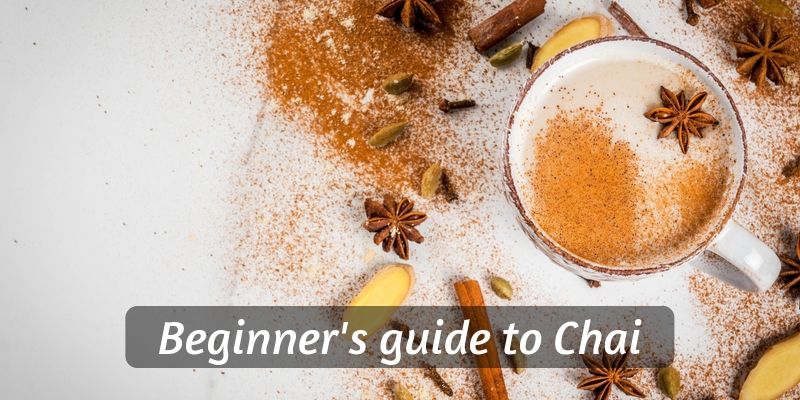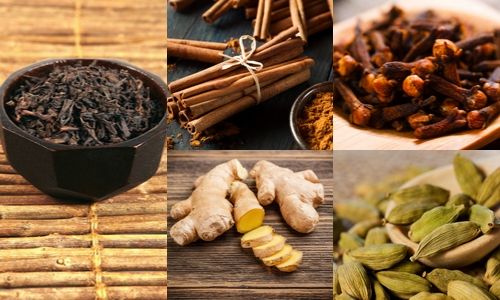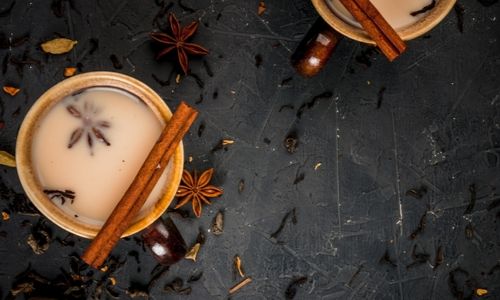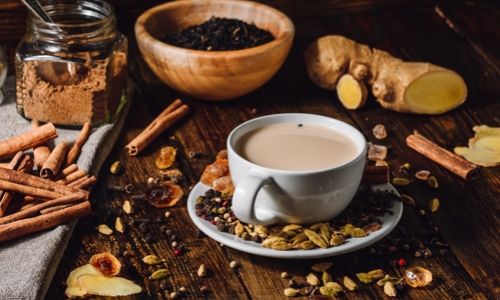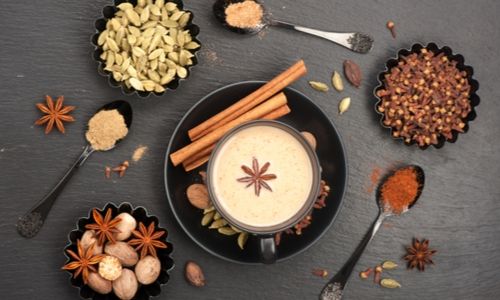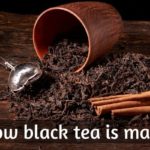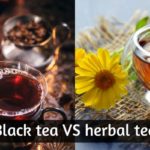Chai tea is that spicy, heavenly tea you often get at Indian restaurants, and lately there's also a Chai latte available for order.
But it's still not a very well known tea, at least in the Western world. So let's go through this beginner's guide to Chai tea, and learn everything we need to really know this tea.
Table of Contents
So what is Chai tea ?
Chai is a type of spiced tea that's native to the Indian subcontinent. Actually, the word 'chai' simply means tea, and is derived from the Chinese 'cha' which also means tea.
The full name of the Chai we all know today is Masala Chai, meaning mixed spice tea, and this is exactly what is in your cup when you order Chai.
The traditional recipe of Chai is black tea leaves mixed with several spices like cinnamon, ginger, nutmeg, clove, black pepper, vanilla, mace, star anise, cardamom, and so on.
Originally each region has its own recipe or way of making Chai, and each family adds even more twists to those customs.
Where is Chai tea from ?
Masala Chai originated from the Indian subcontinent, including Bangladesh, Bhutan, India, Maldives, Nepal, Pakistan and Sri Lanka.
Chai became more popular when trades with India became more frequent, and Indian immigrants made this tea commonplace in the West, starting with Britain.
Now, there's a bit more to say about Chai other than it comes from (mostly) India. It's made of black tea, but also of a whole variety of spices.
Those spices, if you try to track down each of them, grow everywhere in South, East, and Southeast Asia, especially the island part.
So when ordering your Chai you should know that each ingredient comes from a vast geographical area. Most plantations are strictly controlled and produce organic, sustainable growth in each particular country.
What is Chai made from ?
Normally Chai is made from black tea, and a variety of spices. We'll cover the spices shortly, but let's talk about the teas first.
Originally black tea leaves were used to make Chai. This is because the British East India Company wanted to compete with the Chinese monopoly on the tea market and offered land in India to whomever wanted to grow Assam tea on said land.
So, black tea production in India grew and this became the main base for Chai.
However today you'll sometimes find Chai made with green tea, white tea, and even rooibos tea.
As for the spices, please note that Indian folks, when Chai started as a drink, viewed tea as more of a medicine rather than a pleasant drink. Meaning each spice and tea leaf was thought out, and meant to provide health benefits.
Most of them follow ancient Ayurvedic medicinal texts, and as such contain spices that are thought to help the body's overall health.
The most common spices to find in Chai are (in no particular order): cardamom, cinnamon, ginger, clove.
Then you can also find star anise, black pepper, mace, nutmeg, vanilla pods and pretty much any spices that might remind you of autumn, winter, baked goods, pumpkin spice latte, and similar food items.
At times you might also find allspice thrown into the mix. While it's not traditional, it's become an international favorite and may appear in some dishes or drinks that normally would use cinnamon, cloves, and nutmeg.
As for which exact spice combination is present in your particular cup of Chai, that's up to whomever is preparing the tea. If you're ordering from a coffee shop or restaurant they should be able to tell you the spice mix used, or have it listed somewhere on the menu.
If you're the one making the tea, then you can either mix and match you own personal favorites, or you can buy a pre-made spice mix for Chai that's going to suit your needs.
How to make Chai tea
Making Chai is two-fold, you need to steep the spices and you need to steep the black tea leaves.
Now, I understand that using teabags or powdered tea might be more convenient, but nothing beats brewing your own mix of aromatic tea that's going to make the whole house smell wonderful.
So I'm going to explain here how to make loose leaf and spice Chai. If you're looking for the teabag version, it should come printed on the tea pack.
So, to make Chai tea you'll need:
- hot water, just off the boil
- all the spices you'd like to use
- black tea leaves, of whichever kind you like
- sugar and milk to taste
- a medium-sized pot to brew everything in
- a strainer of filter to pass the tea through
- your favorite tea cup/mug
We'll start by figuring out measurements. Keep in mind that for an 8 oz/233 ml serving of tea you'd need 9 oz/266 ml of water, 1 whole teaspoon of black tea leaves, and a teaspoon of spices or possibly a bit more.
Depending on how strong you want your tea, you may want to use more or less tea leaves and spices. Keep in mind that you're going to need to brew this tea stronger, since you're adding some milk to it.
The more milk you add, the less water you need to use. The tea and spice amounts remain the same.
Once your water is boiling, take it off the heat. Add your spices, and let them steep for about 10 minutes for maximum flavor.
Then, add the black tea leaves since these brew faster and turn bitter if you leaves them in too long.
Steep the black tea leaves right in with the spices for 3 minutes, no more no less.
In total, the steeping/brewing time should be 13 minutes. You can steep the spices for just 5 or 7 minutes but you'll get a weaker flavored tea.
After you're done brewing, strain the tea into your cup. Add sugar and milk as you like, and enjoy !
A few notes on making Chai to make everything clear
Adding the spices first and letting them steep longer means more flavor. All spices used are in their dried form, and fairly woody. This means they need more time to release their flavor.
Steeping them at the same time as the black tea would result in a weak flavored tea, and since we're adding milk this isn't what we're looking for.
If using cinnamon, make sure you use whole cinnamon sticks. Powdered cinnamon can't dissolve into anything, since it's essentially just tree bark.
At best it will form a jelly-like substance that might just get in you way when straining the tea. Use whole sticks, this way you're also sure it's fresh.
Using less water for the same amount of tea and spices will mean a stronger flavor tea. Which also leaves room for more milk. f you do this, make sure you heat the milk a little before adding it to the tea since it'll taste better.
Some say you can brew Chai directly in milk. This is not completely true. Some flavor will brew into the milk, but the very structure of milk - being thicker than water - makes it very hard for it to draw out much flavor.
Stick to brewing in water, even if it's just in small amounts. Then add as much milk as you like, and you'll be very pleased with the flavor.
You can use any milk you like. Normally cow milk is used, but you can use other milks, animal or plant based.
Personally I like to add some coconut milk to Chai, since I think it's the final note on a mix of the best flavors ever.
Two of the best Chais out there
I'm going to provide two options here, one in loose leaf form and one for teabags.
This is the organic Chai from Twinings. It comes in a 20-teabag pack, and is easy enough to brew, as long as you follow the instructions on the pack.
Milk can be added to this as well, and each teabag should offer about 8 oz/233 ml of brewed tea.
This tea bland has black tea and cinnamon, cardamom, cloves and ginger. So it leans on the spicy and sweet side of Chai, which is going to be amazing in the colder months, or just in the evening.
You can find the listing on Amazon here, and read the reviews as well.
If you're looking for a loose leaf version of Chai and would like to prepare it to your own specifications, you should try Vahdam.
They have a combination of black tea with crushed cardamom pods, cinnamon, cloves & black pepper. Also on the spicy side but less sweet and more aromatic.
It comes in a vacuum-sealed bag, resealable, and this particular pack can brew up to 50 cups of tea.
Do keep in mind you're going to need to steep this for longer than 3 minutes. The black tea is flavored enough to not let any bitterness get into your cup, so I recommend aiming for at least 5 minutes of steep time.
You can find the listing on Amazon here, and read the reviews as well.
What does Chai tea taste like ?
Chai tea tastes like... everything, really. It's very much like opening the pantry and being hit with all the spices ever, combined.
It's definitely flavorful, heady, and might be a little too much for some people.
Depending on what you use, you might find some very specific tones in your Chai. Here's a few examples.
If you use ginger and black pepper, your tea will always come out spicy, with a nice bite to it. It's amazing during winter.
Using cinnamon, or large amounts of cinnamon will also cause spiciness (but less) and also give a sweet aftertaste. Throw it a little nutmeg and vanilla and your Chai will be mostly sweet, with a warm overtone.
Adding cardamom beans will make it smell very strong, personally I don't like the smell but it's hard to describe. It's slightly astringent.
Cloves and star anise will remind you of mulled wine, and round out the Chai perfectly.
You can use as many or as little spices as you like.
Adding milk to Chai makes it smoother
You can drink Chai without milk, and then the flavors would be a little harder to figure out. There's something about milk in Chai that makes all the other flavors stand out.
Possibly because it provides something for them to contrast with, or maybe because it manages to bend everything together.
Do keep in mind that the more milk you add the more muted the spices will be.
You can use creamer or actual milk, whichever you prefer but remember to use just a little creamer since it can change the flavor a lot.
Do not confuse with Chai latte
Someone took the idea of Chai with milk and ran with it. We now have Chai latte, as an international drink that nearly all baristas know how to prepare.
At its most basic level, it's still Chai - spiced tea with lots of milk. But the milk is steamed and frothed, and served with a nice layer of thick frothed milk on top.
While it's similar in flavor, it's not exactly true Chai. It's often made with Chai extract, and may contain artificial flavorings. You have a higher chance of getting the health benefits associated with Chai by drinking true Chai, instead of Chai latte.
Chai tea health benefits
Chai itself may have some health benefits, however keeping track of them will vary according to whichever spice is used in the making of the tea.
I'll list several of Chai's best health benefits. according to the most common ingredients. The most common ingredients (aside from black tea) are cinnamon, ginger, cardamom, and clove.
Other spices may be added, but these are the most common and what you'll almost always find in your cup of Chai.
1. Black tea is a well known antioxidant source
As a health drink, Chai benefits from having black tea in its ingredient list. It's well know for its antioxidant properties, which in turn lead to some impressive health benefits.
A high antioxidant count has been linked to reducing body weight (1), by helping the body digest and burn fats more efficiently. Black tea has also been linked to lowering insulin tolerance, which in itself may help regular blood sugar and manage body weight and.
Black tea effectively disrupts the absorption of glucose, leading to lower blood sugar. It also seems to disrupt about 25% of total carbohydrates in a crossover study. This again helps in regulating blood sugar.
It's also been shows that black tea lowers lipogenesis (fat production) and enhances lipolisys (breakdown of fats).
2. Cinnamon is an all-around medicine
Cinnamon, especially true cinnamon (Cinnamomum zeylanicum) has been used in medicine for centuries, and is considered to be of great help for respiratory problems and digestion.
A systematic review (2) of other studies done on the effects of cinnamon on health has showed that this spice is versatile and extremely useful. These are the results.
Cinnamon has great anti-microbial and antiseptic properties, meaning it can aid in cleaning wounds and helping the body fight off infections.
It also helps, along with black tea, reduce blood glucose, blood pressure and balance cholesterol levels. It may not be the only spice to do so, but so far this tea is shaping up nicely.
Further, cinnamon has been shown to have a high antioxidant count, which again pairs well with black tea. Also due to the antioxidant count it seems to inhibit early Alzheimer onset.
And although if used in high quantities cinnamon may become spicy, it's actually helpful in inhibiting the apparition if gastric ulcers, and also in treating them.
Finally, cinnamon helps protect the liver and continuous use may improve liver health.
3. Cardamom helps burn fat and lowers insulin resistance
It seems cardamom is joining the party of fat-burning spices. On a study (3) done on rats that were fed a high carb and high fat diet (HCHF) it seems cardamom powder helped in several ways. There was also a control group of regular diet rats, to compare results.
First, cardamom lowered glucose intolerance and insulin resistance significantly. Glucose intolerance is a pre-diabetes sign, as well as a sign of already developed diabetes.
Second, cardamom powder managed to significantly prevent the rise of fat content in the HCHF diet fed rats. This was especially observed in the fat content of the liver.
In short, at least in animal studies, cardamom seems to have strong fat-burning properties, and also protects the liver from fatty liver disease and the body from oxidative stress (free radicals, combated by antioxidants).
Another study comparing 3 types of cardamom found that they all had strong antifungal and antimicrobial properties (4), as essential oils.
4. Clove is high in antioxidants, protects health
Clove is a less studied spice than the ones you'll usually find in a Chai recipe. However it's one of the most common spices in Chai, and is present in nearly every version of the tea.
It seems clove has a high antioxidant count (5), which contributes to inhibiting fat deposits and increasing one's metabolism.
And it's also been proven during a study done on mice (6) that clove oil may revert memory and learning deficits, when this was caused by oxidative stress. This was observed in short term and long term effect.
5. Ginger is anti-inflammatory and high in antioxidants
It seems pretty much everything on the ingredient list of Chai spices is meant to preserve health, raise metabolism and generally help the body be in its best shape.
Ginger, like so many others on this list, is high in antioxidants (7) which results again in enhanced fat-burning and increased metabolism.
It's also got anti-inflammatory properties, meaning it will also help in cases of sore throats if your particular Chai has a high ginger content.
Ginger oil may also help relieve muscle pain, as well as improve gastrointestinal health. It also helps protect the liver, particularly from toxins and aids in cleansing it (8).
Is Chai tea caffeine free ?
No necessarily. Chai does contain caffeine, but there are decaffeinated versions available.
Firstly, Chai has caffeine due to the black tea content. While it may not be a lot of black tea, it's still enough to provide a measure of caffeine. Hence why some folks try replacing their morning coffee with black tea, and often succeed.
That being said, if you get your hands on a decaf version of Chai, you're going to get barely any caffeine. There will still be some caffeine, but barely noticeable so highly sensitive individuals may not be affected.
The only way to be sure you're getting truly caffeine-free Chai is to ask for rooibos Chai. This is Chai that uses rooibos tea (which is caffeine free) instead of black tea, and then the rest of the usual spices. It's usually a milder, sweeter tea.
However, if you're looking to raise the caffeine content of your Chai then try a dirty Chai latte. All that is is a regular Chai latte with a shot of espresso added in it.
You can make your own at home, even without turning it into a latte.
Conclusion
Chai is a delicious way to explore Indian cuisine and drinks, and most often folks fall deeply in love with it. Whether you take your Chai simple, a latte, or a dirty latte you're bound to like it.
Personally I like to add a little powdered creamer instead of milk, simply because it's going to give it that nice, creamy flavor without turning it into too big of a cup of tea, or removing any strength.
If you want to know more about coffee or tea, feel free to check the related articles below. Who knows what else you might find ?
References
1. Mechanisms of Body Weight Reduction by Black Tea Polyphenols
2. Medicinal properties of ‘true’ cinnamon (Cinnamomum zeylanicum): a systematic review
4. Chemical and Biological Evaluation of Essential Oils from Cardamom Species
5. Clove (Syzygium aromaticum): a precious spice
6. Clove oil reverses learning and memory deficits in scopolamine-treated mice.
8. Prevention of CCl4-induced liver damage by ginger, garlic and vitamin E.

